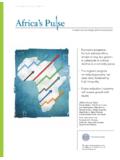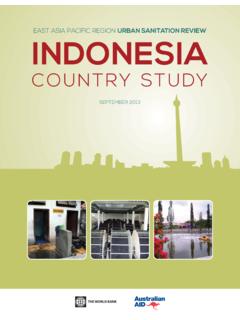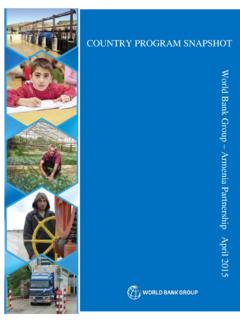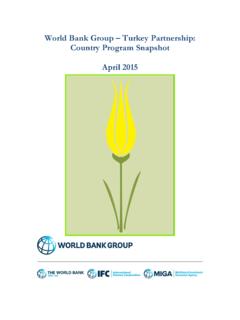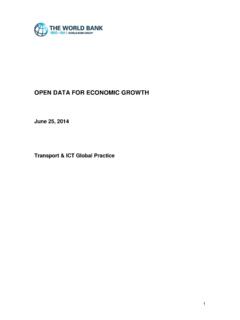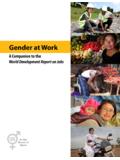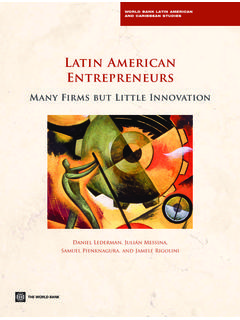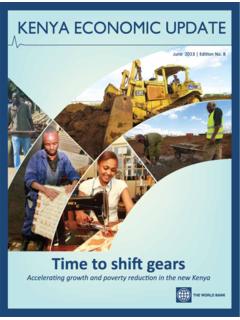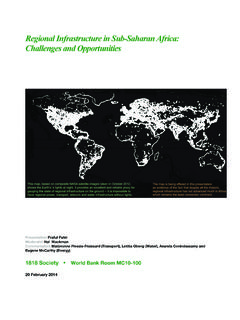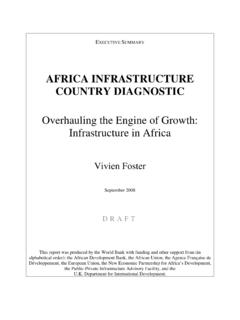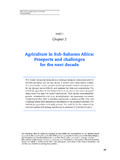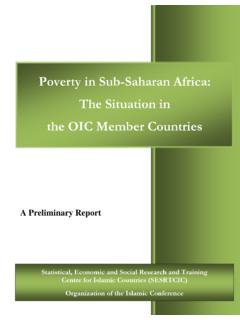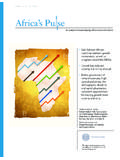Transcription of Youth Employment in Africa: Overview - World Bank
1 Youth Employment in Sub- saharan africa Deon Filmer The World bank December 2013. Main Findings Unemployment (of urban educated graduates who want to work in the wage sector) is just the tip of the iceberg The Youth Employment problem is about pathways to productive work in agriculture, household enterprises, as well as the modern wage sector with priority actions on the human capital as well as the business environment side The Opportunity: africa 's Youth Bulge Sub- saharan africa 2015, 2035 South Asia 2015, 2035. 80+ 80+. 70-74 70-74. 60-64 60-64. 50-54 50-54. 40-44 40-44. 30-34 30-34. 20-24 20-24. 10-14 10-14.
2 0-4 0-4. -100 -80 -60 -40 -20 0 20 40 60 80 100 -100 -80 -60 -40 -20 0 20 40 60 80 100. Population in millions Population in millions Male 2015 Female 2015 Male 2015 Female 2015. Male 2035 Female 2035 Male 2035 Female 2035. Source: United Nations, Department of Economic and Social Affairs, Population Division (2011). World Population Prospects: The 2010 Revision. 3. Commodity exports have shaped recent changes in economic structure Over the past two decades, agriculture's share in GDP contracted in africa , but manufacturing did not replace it Low income countries Low-Middle income countries 1990 2010 1990 2010 1990 2010 1990 2010 1990 2010 1990 2010.
3 SSA South Asia East Asia SSA South Asia East Asia Agriculture Industry (exc. Manufacturing) Agriculture Industry (exc. Manufacturing). Manufacturing Services, etc. Manufacturing Services, etc. Most Africans are not unemployed they work in agriculture and household enterprises 100%. 90%. Labor Force Distribution 15-64. 80%. 70%. 60%. 50%. 40%. 30%. 20%. 10%. 0%. Low Income Lower-Middle Resource Rich Upper-Middle Total Income Income 183 m 40 m 150 m 21 m 395 m Agriculture HE Wage Industry Wage Services Unemployed The SSA Youth Challenge: a long transition to work, especially in urban areas Rural Urban Proportion Proportion 15 17 19 21 23 25 27 29 31 33 15 17 19 21 23 25 27 29 31 33.
4 Age Age Working At School Both Working and at School Not at School, Not Working, Looking for Work Where will the new jobs come from? Projected new jobs in 2020 compared with structure in 2010. 300. 250. Labor force (millions). 200. 150. 100. 50. 0. Agriculture Household Wage Industry Wage Services Enterprises 2010 New Jobs in 2020. Priority Actions A cross-cutting agenda on education quality Education determines opportunities . Education Profile of Workers ages 25-34 in each Sector 100. 80. 60. 40. 20. 0. Agriculture Non-farm Wage Wage with All household without contract enterprise contract No Education Primary incomp.
5 Primary comp. Secondary +. Percent -80. -60. -40. -20. 100. -100. 0. 20. 40. 60. 80. SACMEQ Low SES. High SES. Zambia Low SES. High SES. Namibia Low SES. High SES. Malawi Low SES. High SES. South africa Low SES. High SES. Competent and above (Level 5,6,7,8). Lesotho Low SES. High SES. Zanzibar Low SES. High SES. Pre, Emergent and Basic numeracy (Levels 1,2,3). Uganda Low SES. High SES. Mozambique Low SES. High SES. Botswana Low SES. High SES. Zimbabwe Low SES. High SES. Seychelles Low SES. But quality is key challenge High SES. Swaziland Low SES. Beginning numeracy (Level 4). High SES. Tanzania Low SES.
6 High SES. Mauritius Low SES. High SES. Kenya Low SES. High SES. Percent of SACMEQ 6th grade test-takers at each mathematics performance level, by SES. Severe Shortfalls in the Delivery of Education Services Service Delivery Indicators Kenya Nigeria* Senegal Tanzania Uganda (Public schools only). School teacher absence rate 16% 16% 18% 23% 27%. Classroom teacher absence rate 47% 25% 29% 53% 57%. Share of teachers with minimum knowledge: English/French 10% 5% 29% 9% 4%. Mathematics 75% 7% 75% 73% 36%. Classroom teaching time 2h 19m 3h 17m 3h 15m 2h 04m 2h 58m (scheduled teaching time) (5h 40m) (4h 43) (4h 36m) (5h 12m) (7h 20m).
7 * Nigeria SDI covers 6 States. Preliminary findings shown. Priority Actions For agriculture For household enterprises For the modern wage sector In agriculture, Youth need land and support to make it productive Land ownership by age group Opportunities and constraints 80. 70 Growing demand for food 60 produced on africa 's farms . 50 domestically and exports Percent 40 Youth can be early adopters of 30 new technology if it is 20 available 10. 0. Age Malawi Tanzania Uganda Priorities for productivity in agriculture Do now, for now Do now, for later Enable rental markets for land Establish effective land registration and transaction Support high-quality, demand- systems driven extension services Scale up intergenerational (covering information as well land transfer programs as skills) Mainstream Youth into Promote rural village savings interventions (producer organizations, livestock and loan associations and self- development, irrigation, and help groups others).
8 Link agricultural credit to Build skills through rapid extension services improvements in education systems in rural areas Household Enterprises are not SMEs they need their own approach, and Youth need support to seize opportunities Most enterprises are family Youth struggle to start a business operations 35. 80 30. 70 25. Percent 60 20. 50 15. Percent 40 10. 5. 30. 0. 20. 15 - 19. 20 - 24. 25 - 29. 30 - 34. 35 - 39. 40 - 44. 45 - 49. 50 - 54. 55 - 59. 60 - 65. 66+. 10. 0. Self Self With 1-4 5+. Distribution of HE owners Employed Employed Employees Employees with Family Share of age group being in HE owners Helpers Priorities for productivity in household enterprises Do now, for now Do now.
9 For later Develop a national strategy that Build foundational skills reflects the voice of Youth and household enterprise owners through rapid Ensure access to workspace and improvements in education infrastructure for household enterprises through improved systems urban policy Address infrastructure Leverage NGOs to deliver interventions that support needs of household disadvantaged Youth to enter the enterprises in urban sector by addressing multiple constraints (building a range of development planning skills together, building skills along with providing access to finance). Financial inclusion for family farms and enterprises, as well as households African Youth save, but not in Households, and farm or banks ( Youth 15-24 who save).
10 Business finances comingled 30 Households need place to save and to get credit 25. Youth need savings to start a 20. business or buy inputs for the Percent 15 farm, and a place to safeguard 10. profits Mobile money shows promise 5. but need better regulations 0. Low income Lower- middle Upper- middle Low income Lower- middle Upper- middle Informal savings groups are income SSA. income income Rest of the World income filling the gap, especially in Formal Informal/Club Other rural areas A manufacturing strategy won't solve today's Youth Employment , but it will help the next generation Manufacturing Employment has Game changer scenario takes grown slowly time to have an effect 300 100.
